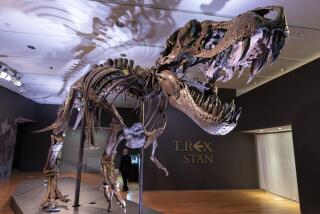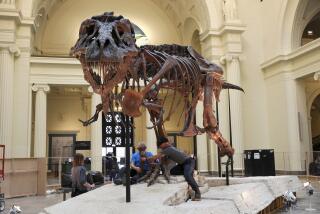Throat infection may have brought down T. rex
Did Sue the dinosaur die of a really bad sore throat?
An international team of scientists thinks so after studying holes in the jaw of the 13-foot-tall Tyrannosaurus rex skeleton on display at the Field Museum in Chicago.
“It’s a distinct possibility that Sue died of starvation by a substantial infection in the back of the throat” brought on by a tiny parasite, said Ewan Wolff, a paleontologist at the University of Wisconsin-Madison and lead author of a paper describing the team’s findings published Tuesday in the online science journal PloS One.
In the past, Wolff said, many paleontologists have speculated that the holes in Sue’s jaw were caused by bite marks that were a product of Sue’s rampaging lifestyle. T. rexes were among the largest meat-eaters on Earth during their reign in the Cretaceous period 144 million years ago. They had to eat a lot, and often, to support their enormous bodies.
But Wolff and his team propose a much more prosaic cause for Sue’s decline: a disease called trichomonosis that infects modern birds of prey. Birds, which are thought to be direct descendants of dinosaurs, pick up the bug by feeding on other animals infected with the disease, Wolff said.
Wolff thinks the parasite, a protozoan named Trichomonas gallinae, settled in the back of Sue’s throat, and in nine other Tyrannosaurs he studied with similar holes. The parasite caused inflammation that eventually damaged the jawbone, he theorized. As the infection worsened, the throat swelled to a point that “the esophagus gets narrower and narrower,” Wolff said. “Death is by starvation.”
“People have speculated in the past about the holes in the jaw,” said Mark Goodwin, a paleontologist at UC Berkeley. “The strength of this paper is that it presents a hypothesis and tests it.”
Wolff said the team looked at the holes in Sue’s jaw, and in the other nine skeletons, for evidence of tooth marks but found none. The damage to the bone was much more indicative of disease, he said.
Sue was found in 1990 in the Black Hills of South Dakota by a fossil hunter named Sue Hendrickson, for whom the skeleton is named.
--




